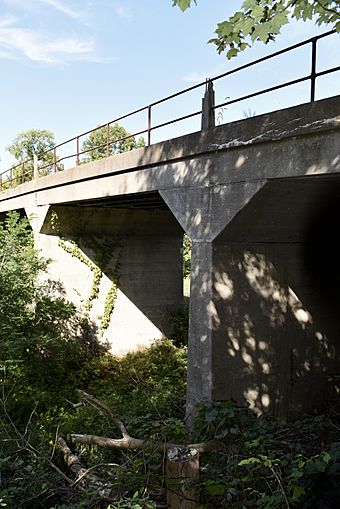Thomson Road–Air Line Railroad Bridge facts for kids
Quick facts for kids |
|
|
Thomson Road–Air Line Railroad Bridge
|
|
 |
|
| Location | Thomson Rd. over abandoned RR right-of-way, Howard Township, Michigan |
|---|---|
| Area | less than one acre |
| Built | 1919 |
| Architectural style | concrete T-beam |
| MPS | Highway Bridges of Michigan MPS |
| NRHP reference No. | 99001612 |
| Added to NRHP | December 22, 1999 |
The Thomson Road–Air Line Railroad Bridge is a special old bridge in Howard Township, Michigan. People also call it the Thomson Road Bridge. It crosses over an old, unused railroad track. This bridge is so important that it was added to the National Register of Historic Places in 1999. It's one of the oldest bridges in Michigan made with a special design called a concrete T-beam. Plus, it has a very unusual deck (the part you drive on) made of bricks!
The Bridge's Story: How It Was Built
Long ago, in 1848, a main train track called the Michigan Central Railroad was built through Cass County. This was about half a mile west of where the bridge is now.
After the American Civil War, a new train line was built. It was called the Michigan Air Line Railroad. This new line connected Jackson to the Michigan Central line in Niles.
Just two years later, the Michigan Central company took over this new train route. In 1919, a shortcut was built through Howard Township. This shortcut connected the main Michigan Central line to the Air Line. The Thomson Road Bridge was built at the same time. It was likely designed by the railroad company itself.
Today, the train tracks under the bridge are no longer used. They have been abandoned for many years and are now covered with plants.
What Makes This Bridge Special?
The Thomson Road–Air Line Railroad Bridge is a very old example of a concrete T-beam bridge in Michigan. It's also the only important bridge of its kind that has many sections, or "spans."
The whole bridge is about 169 feet long. It is just over 20 feet wide. It has five sections, each about 35 feet long. The bridge is so long because the area underneath was once a wide train yard. This yard was used for switching trains and was known as the "Hump."
The bridge has a unique deck, which is the part cars drive on. It's made of bricks and has a slight arch shape. The original railings on the bridge are still there. They are metal pipes stretched between concrete posts. The bridge is in excellent condition, looking much like it did when it was first built!



